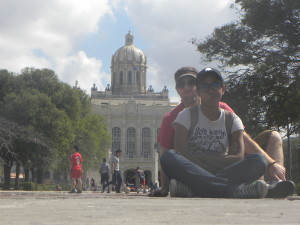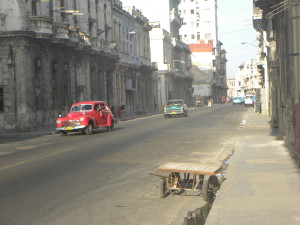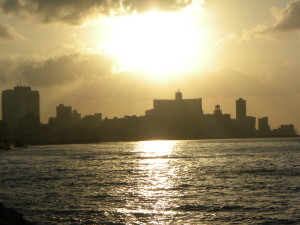
The view from our balcony at Magda’s casa.
Hi everyone! I’m Analin Saturria McGregor am very excited to contribute to Oh Hey World as a guest writer. I discovered a new way of traveling 6 years ago when a friend invited me to the beautiful Samaná peninsula in my native Dominican Republic. Growing up during the expansion of the all-inclusive vacation tourism model, I had never dreamed that there could be a more meaningful, engaging and fun way to travel. I’m now an independent traveling convert and have relocated to Shanghai, China with my husband after two years in the Dominican Republic. This first post is about our first big travel adventure together: Cuba!
If you want to go to Cuba, make it happen! Go now, while that charm that has made Cuba famous is still there. The Dominican Republic is an easy place to do it from since travel between the two islands is fairly easy to figure out. If you have the time and the money you can also plan some time in the Dominican and some time in Cuba –two birds with one stone.
10 of my favorite things about Havana:
1) Staying at a casa particular – After seeing how Havana has so many tourist trap places, I have to say staying at a Casa Particular gave us a freedom we would have probably not enjoyed staying at a hotel. Hotels in Havana are, in my opinion, quite overwhelming – you get bombarded with multiple offers from guides, vendors, etc., to do things their way, which usually involves some sort of prepackaged fashion of what they assume is what every tourist should see. We also got to help a Cuban family directly (remember, in Cuba, all hotels are operated by the government through a number of companies established for this purpose. Even the ones who may be operated by foreign chains, such as Melia or Iberostar, are still under a government concession). In our case, Magda has just started with her Casa business and we were one of her first guests. If you want her Casa’s contact info you can message me. We made our own itinerary, took whatever risks we were okay with taking, and were pretty much undisturbed for the whole week. Magda made us breakfast herself every day (even placing the fruit in a happy face shape every morning – adorable), which was an interesting assessment of the food issues most Cubans face. For example, one day there was no bread on our breakfast because bakeries had no flour yet so no one had been able to bake any fresh bread. Also, casas are significantly cheaper than hotels – about half the price than a budget hotel, which allows for spending a little more on attraction fees or nicer dining.
2) Going to local places to eat – In most local places, prices are quoted in Moneda Nacional, which is a lot cheaper than the more widely used in tourist areas, Cuban Convertible Peso. In many places, you can pay with either (1 US$= 24 Cuban Peso/Moneda Nacional, vs. 1 US$=1CUC). Portions are HUGE. First day out we went to this Chinese restaurant in Centro Habana’s Chinatown. We had to go up some stairs and it kind of looked like a place where small-scale mobsters would eat (at least movie mobsters), but the food was great (just like any American Chinese takeout restaurant) and we had enough leftovers for dinner and a bit of a midnight snack post-drinks. Total bill=something like US$5, including drinks). Another day we decided to go to this cafeteria that we had passed by a different day. The important thing here was that the place was PACKED. My husband, a more experienced traveler than me, always tells me: “pay attention to where the locals go. If there are a lot of locals there, it’s got to be good, and probably cheap”. They had no sitting, just tables you stood around, so it really was packed. It was basically as large as 6 feet of sidewalk. Portions? Huge. Finishing my sandwich was a tough task. My husband was nowhere near finishing his plate of rice, beans, pork and salad. If my memory serves me right we paid about $4.50 CUC for that meal. I might have not looked very happy while we were eating (it was hot and eating while standing up is not the best thing after walking all morning) but it was a cool experience. Couple of things: in Cuba you have to pay for any takeout containers – imported Styrofoam (cringe). Also, since you can’t drink the tap water, you should always keep bottled water with you – but buy it in stores away from the tourist areas if you can. Price of a 1.5 liter bottle of water at the local store: about 70 CUC cents. At the touristy area shops, the same 70 cents will just get you a 10-ounce bottle.

View of Havana from the lighthouse binoculars. El Castillo del Morro, Havana.
3) Taking our time with Havana and not overexerting ourselves – Initially we were keeping the option of traveling to other cities in Cuba in the back burner, but the city that we were truly interested in visiting was Santiago (second largest city in Cuba anyway) but decided against it due to distance. Domestic flights in Cuba are not exactly reliable (planes are outdated and often flights are delayed due to missing parts) and my husband has already done his fair share of scary domestic flights in Russia. The other option was the bus, but it’s an 11-hour drive. Didn’t really feel like losing two days to Santiago and back since we just had a week. After I came back I remember talking to a friend who had gone to Cuba not long before with a student group, and her comment about how much she deeply regretted not being able to stay put for longer, and just explore. For a weeklong trip, I would probably limit my trip to one or two locations, tops, due to the potential transport delays you could encounter.
4) Visiting El Castillo del Morro – In my opinion, the best attraction in Havana. My absolute favorite. First of all, you have to take a taxi to go there, so great opportunity to take a classic car. We rode in a ’49 Chevy. You can negotiate on price with them and if you ask, they will wait for you until you’re done and take you back. El Castillo del Morro was built to defend Havana and was an important defense point in the 1700s. It’s kept in wonderful shape and has very good exhibits. No need to hire a guide, you’re pretty much free to roam around the fort as much as you want. Save your guide money to pay for lighthouse access (it does cost extra to go up the lighthouse but it is a wonderful, wonderful point to get bird’s eye views of Havana. Getting the whole view of the skyline lets you see the striking difference between Old Havana and the newest districts in the city (most specifically Vedado). You can also get a pretty good idea of what inner city Havana (or Centro Habana) looks like. Get up here with a camera that allows for taking panoramic pictures – you will not regret it.

El Castillo del Morro – view from the Havana waterfront.
5) The cafeteria at Sociedad Asturiana – the Sociedad Asturiana is located at Paseo del Prado, the gateway to Old Havana coming from the Malecón. It’s a Spanish-founded cultural venue which holds live music, dance classes, etc. We saw a flamenco rehearsal one day. It was so elegant!). I believe we saw their ground floor cafeteria, Zana, on the way home one particularly hot evening. They sell in Moneda Nacional (Cuban peso), so we could get coffee and a “coffee cake” for about $2 CUC in the end). Those rolls were heaven. Not too cakey and not too bready, sweet, delicious and big. They also made great steak sandwiches (or pan con bistec – I’d call this the Cuban equivalent of a Philly Cheese Steak without the cheese and with thicker steak) and burgers.
6) Multiple transportation options, yet very walkable – Havana is a fairly flat city, so walking is not exactly challenging, and the city is laid out on a pattern that makes it quite easy to find your way. Also, if you’re walking, you’re free to take your precious time and look closely to what YOU think it’s important. The Malecón is a fabulous reference point. When you get tired of walking, hop on a Coco-Taxi. Coco-taxis are the clever and heat-proof way to take a motorcycle taxi: it’s a motorcycle with an circular sort of attachment on the back that seats three. They are open on the sides, so if it rains, you might get sprinkled on the legs, but who cares? These transport tourists and locals alike.

Vintage taxi and coco-taxi strolling down Havana’s waterfront.
7) The photography opportunities! – Even the tattered buildings have indescribable beauty to them, you will get glimpses into the lives of Cubans you will not get or hear from any tour guide in Old Havana. Our waterfront location granted fantastic picture opportunities all day long. During our first three days in Havana, we took close to 3000 pictures. A building that might seem run-down and not worth a picture might change completely under a different sunlight, or once you bother to discover it.
8) Detouring through side streets in Centro Habana – We had read mixed reviews about Centro Habana’s safety, so we didn’t really walk through side streets at nighttime. During the day, however, it was fun to get glimpses of what Cubans’ lives are like: people cooking, hanging clothes, people-watching on their balconies, drinking and chatting, playing dominoes or music, repairing their vehicles with makeshift parts, playing baseball, watching baseball, coming to and from school. We also walked by some smaller businesses and witnessed long lines while people waited for their rations. Go to Old Havana, and all you see is white people.
9) Smoking cigars at the fancy hotels – Talk about a way to feel glamorous Old-Hollywood style. Sipping daiquiris and smoking our Romeo y Julietas while sitting on the Hotel Nacional’s gorgeous terrace overlooking the ocean…wow…straight out of any 60s TV show episode, regardless of your outfit. The fancy hotels will have either a store (at the basement in Hotel Nacional) or a cart (at the lobby at Hotel Parque Central), all run by very knowledgeable ladies that can recommend the Cuban that better suits the type of smoke you want to have.
10) The bomb shelter/tunnel at Hotel Nacional – This hotel, a National Monument in its own right, is possibly one of the most beautiful buildings in all of Havana. You can walk through their halls filled with pictures of celebrities during their visits to Cuba and world leaders visiting with Fidel Castro. Upon walking on their cliff-side gardens, we stumbled upon a shelter built during the Cuban missile crisis. The shelter includes illustrations of how the Cuban army used this secret point to spy on the American ships stationed facing Havana. We got a walk-through by its friendly guide, who will vividly explain the importance of this shelter over and over during the walking tours of Hotel Nacional – worth doing and better yet, it’s free. Make sure to take some change with you to tip guides.
Check back next week for the 11 most surprising part of my travels through Cuba, as well as tips for planning your own trip!





























 It wasn’t until one of my professors suggested I join the Peace Corps that I began to think seriously about postponing graduate school. As he explained why he felt so strongly, I pushed back. “Think of it like a master’s degree in life,” he said. And that got my attention.
It wasn’t until one of my professors suggested I join the Peace Corps that I began to think seriously about postponing graduate school. As he explained why he felt so strongly, I pushed back. “Think of it like a master’s degree in life,” he said. And that got my attention. The very next day for the very same group of students, I was forced to teach outside under a tree because the school guard had wandered off with our key. That evening I rewired the electricity in my house because I didn’t have the language skills to explain to my landlady what the problem was. A few weeks later when summer began, I hiked out to an ancient, remote rock-hewn church and accepted a coffee invitation from a kind priest. Through the dry season that followed I carried water with my neighbors and while we walked, we discussed their lives and the things that made them happy. Further along in my service, after witnessing a child succumb to a treatable heart defect, I cried with her family and silently vowed to be grateful forever for the medical treatment I am afforded as a citizen of a developed nation.
The very next day for the very same group of students, I was forced to teach outside under a tree because the school guard had wandered off with our key. That evening I rewired the electricity in my house because I didn’t have the language skills to explain to my landlady what the problem was. A few weeks later when summer began, I hiked out to an ancient, remote rock-hewn church and accepted a coffee invitation from a kind priest. Through the dry season that followed I carried water with my neighbors and while we walked, we discussed their lives and the things that made them happy. Further along in my service, after witnessing a child succumb to a treatable heart defect, I cried with her family and silently vowed to be grateful forever for the medical treatment I am afforded as a citizen of a developed nation.